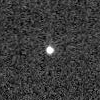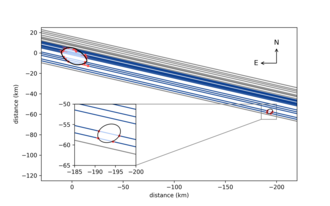15094 Polymele
 Polymele imaged by the Hubble Space Telescope in 2018 | |
| Discovery[1] | |
|---|---|
| Discovered by | Catalina Sky Survey |
| Discovery site | Catalina Station |
| Discovery date | 17 November 1999 |
| Designations | |
| (15094) Polymele | |
| Pronunciation | /pɒlɪˈmiːliː/[2] |
Named after | Polymele (Greek mythology)[1] |
| 1999 WB2 · 1997 WR57 | |
| Jupiter trojan[1][3] (Greek camp)[4] | |
| Orbital characteristics[3] | |
| Epoch 25 February 2023 (JD 2460000.5) | |
| Uncertainty parameter 0 | |
| Earliest precovery date | 30 November 1951[1] |
| Aphelion | 5.682 AU |
| Perihelion | 4.679 AU |
| 5.180 AU | |
| Eccentricity | 0.0968 |
| 11.79 yr (4,307 d) | |
| 44.314° | |
| 0° 5m 0.936s / day | |
| Inclination | 12.981° |
| 50.319° | |
| 4.772° | |
| Jupiter MOID | 0.2445 AU |
| TJupiter | 2.940 |
| Physical characteristics | |
| Dimensions | 27.0 × 24.4 × 10.4 km[5] (± 2.0 × 1.6 × 1.6 km) |
Mean diameter | 21.075±0.136 km[6][7] |
Mean density | 0.7–1 g/cm3 (assumed)[5] |
| 5.8607±0.0005 h[8] | |
| 170.9° (wrt ecliptic)[5] | |
Pole ecliptic latitude | −80.9°±2.1°[5] |
Pole ecliptic longitude | 231.8°±4.5°[5] |
| 0.073[8] 0.091±0.017[3] | |
| P[9] B–V = 0.652±0.065[10] V–R = 0.477±0.065[10] V–I = 0.799±0.068[10] | |
| 11.60[1][3][7][11][12] 11.691±0.002 (S/R)[8] | |
15094 Polymele /pɒlɪˈmiːliː/ is a primitive Jupiter trojan from the Greek camp, approximately 21 kilometers (13 miles) in diameter. It is a target of the Lucy mission with a close flyby planned to occur in September 2027.[9][13] It was discovered on 17 November 1999, by astronomers with the Catalina Sky Survey at Mount Lemmon Observatory, Arizona, in the United States. The P-type asteroid has a rotation period of 5.9 hours and highly flattened shape.[14][15] It was named after Polymele from Greek mythology, the wife of Menoetius and the mother of Patroclus.[1] In 2022, it was reported to have a natural satellite approximately 5 kilometers (3.1 miles) in diameter.[16]
Orbit and classification[edit]
Polymele is a Jupiter trojan asteroid orbiting in the leading Greek camp at Jupiter's L4 Lagrangian point, 60° ahead of the gas giant's orbit (see Trojans in astronomy). It orbits the Sun at a distance of 4.7–5.7 AU once every 11 years and 9 months (4,289 days; semi-major axis of 5.17 AU). Its orbit has an eccentricity of 0.09 and an inclination of 13° with respect to the ecliptic.[3] The asteroid's observation arc begins 48 years prior to its official discovery observation at Mount Lemmon, with a precovery taken at Palomar Observatory in 1951, and published by the Digitized Sky Survey later on.[1]
Naming[edit]
This minor planet was named after Polymele, the daughter of Peleus from Greek mythology. According to the Latin author Gaius Julius Hyginus (c. 64 BC – AD 17), she is the wife of the Argonaut Menoetius and the mother of Patroclus, who participated in the Trojan War.[1] Polymele is also known as "Philomela"; that name was previously used for the asteroid 196 Philomela. The approved naming citation was published by the Minor Planet Center on 22 February 2016 (M.P.C. 98711).[17]
Physical characteristics[edit]
Polymele has been characterized as a primitive P-type asteroid by the investigators of the Lucy mission.[9] P-type asteroids are known for their low albedo. It has a V–I color index of 0.799,[10] which is lower than that for most larger Jupiter trojans (see table below).
Size, shape, and albedo[edit]
According to the survey carried out by the NEOWISE mission of NASA's Wide-field Infrared Survey Explorer, Polymele measures 21.075 kilometers in diameter and its surface has an albedo of 0.091,[6][7][11] while in 2018, Marc Buie published an albedo of 0.073 and an absolute magnitude of 11.691 in the S- and/or R band.[8] The Collaborative Asteroid Lightcurve Link assumes a standard albedo for a carbonaceous asteroid of 0.057 and calculates a larger diameter of 26.64 kilometers based on an absolute magnitude of 11.6.[12]
On 27 March 2022, multiple astronomers observed a stellar occultation by Polymele, which revealed an apparently elongated projected shape with projected dimensions of 26.2 km × 12.8 km (16.3 mi × 8.0 mi).[14] Additional occultation observations of Polymele from 2020–2023 revealed that Polymele's true shape is a highly flattened disk with dimensions 27.0 km × 24.4 km × 10.4 km (16.8 mi × 15.2 mi × 6.5 mi), similar to the large flat lobe of the Kuiper belt object 486958 Arrokoth.[15] This unusual flattened shape of Polymele implies that it had retained its original shape from when it formed by accretion.[15]
Rotation[edit]
In March 2016, a rotational lightcurve of Polymele was obtained from photometric observations by Marc Buie and colleges. Lightcurve analysis gave a rotation period of 5.8607±0.0005 hours with a small brightness amplitude of 0.09±0.03 magnitude (U=2-), which indicates the body is being viewed pole-on.[8] Previously, the Lucy mission team published spin rates of 6.1 and 4 hours, respectively.[9][13]
The resolved observation of Polymele's shape in multiple occultation events allowed the Lucy team to determine the orientation of Polymele's rotational pole.[5] Polymele's rotational north pole points toward ecliptic latitude –80.9°, which corresponds to an axial tilt of 170.9° with respect to the ecliptic, making Polymele a retrograde rotator.[5]
Satellite[edit]

Following observations of an occultation on 26 March 2022, the Lucy mission team reported the discovery of a natural satellite around Polymele. The satellite is a smaller asteroid about 5–6 kilometers (3.1–3.7 miles) in diameter, orbiting nearly in the equatorial plane of Polymele at a distance of 204.4 ± 2.6 km (127.0 ± 1.6 mi).[14][5] Assuming Polymele has a density of 0.7–1 g/cm3, the satellite should have an orbital period between 14.4 and 16.6 days.[5] It will not be assigned a formal name until further observations determine its orbit.[18] The Lucy team refers to the companion by the temporary informal name "Shaun," after Aardman Animations' animated sheep.[16] The satellite was detected again in an occultation on 4 February 2023,[15] in the largest organized occultation expedition in history. Nearly 200 astronomers across two continents participated in the campaign.[19]
Exploration[edit]
Lucy mission target[edit]
Polymele is planned to be visited by the Lucy spacecraft which launched in 2021. The flyby is scheduled for 15 September 2027, and will approach the asteroid to a distance of 415 km (258 mi) at a relative velocity of 6 km/s (13,000 mph).[9]
References[edit]
- ^ a b c d e f g h "15094 Polymele (1999 WB2)". Minor Planet Center. Retrieved 8 March 2018.
- ^ 'Polymela' in Noah Webster (1884) A Practical Dictionary of the English Language
- ^ a b c d e "JPL Small-Body Database Browser: 15094 Polymele (1999 WB2)" (2015-06-10 last obs.). Jet Propulsion Laboratory. Retrieved 26 September 2018.
- ^ "List of Jupiter Trojans". Minor Planet Center. 20 June 2016. Retrieved 8 March 2018.
- ^ a b c d e f g h i Levison, H. F.; Buie, M. W.; Keeney, B. A.; Mottola, S.; et al. (June 2023). Interpreting the Stellar Occultations of (15094) Polymele – a Lucy Target (PDF). Asteroids, Comets, Meteors Conference 2023. Lunar and Planetary Institute.
- ^ a b Grav, T.; Mainzer, A. K.; Bauer, J. M.; Masiero, J. R.; Nugent, C. R. (November 2012). "WISE/NEOWISE Observations of the Jovian Trojan Population: Taxonomy". The Astrophysical Journal. 759 (1): 10. arXiv:1209.1549. Bibcode:2012ApJ...759...49G. doi:10.1088/0004-637X/759/1/49. S2CID 119101711. (online catalog)
- ^ a b c Mainzer, A. K.; Bauer, J. M.; Cutri, R. M.; Grav, T.; Kramer, E. A.; Masiero, J. R.; et al. (June 2016). "NEOWISE Diameters and Albedos V1.0". NASA Planetary Data System: EAR-A-COMPIL-5-NEOWISEDIAM-V1.0. Bibcode:2016PDSS..247.....M. Retrieved 26 September 2018.
- ^ a b c d e Buie, Marc W.; Zangari, Amanda M.; Marchi, Simone; Levison, Harold F.; Mottola, Stefano (June 2018). "Light Curves of Lucy Targets: Leucus and Polymele" (PDF). The Astronomical Journal. 155 (6): 11. Bibcode:2018AJ....155..245B. doi:10.3847/1538-3881/aabd81. Retrieved 26 September 2018.
- ^ a b c d e Levison, H. F.; Olkin, C.; Noll, K. S.; Marchi, S.; Lucy Team (March 2017). "Lucy: Surveying the Diversity of the Trojan Asteroids: The Fossils of Planet Formation" (PDF). 48th Lunar and Planetary Science Conference (1964): 2025. Bibcode:2017LPI....48.2025L. Retrieved 13 April 2017.
- ^ a b c d Hainaut, O. R.; Boehnhardt, H.; Protopapa, S. (October 2012). "Colours of minor bodies in the outer solar system. II. A statistical analysis revisited". Astronomy and Astrophysics. 546: 20. arXiv:1209.1896. Bibcode:2012A&A...546A.115H. doi:10.1051/0004-6361/201219566. S2CID 54776793.
- ^ a b Mainzer, A.; Grav, T.; Masiero, J.; Hand, E.; Bauer, J.; Tholen, D.; et al. (November 2011). "NEOWISE Studies of Spectrophotometrically Classified Asteroids: Preliminary Results". The Astrophysical Journal. 741 (2): 25. arXiv:1109.6407. Bibcode:2011ApJ...741...90M. doi:10.1088/0004-637X/741/2/90. S2CID 118700974. (catalog)
- ^ a b "LCDB Data for (15094) Polymele". Asteroid Lightcurve Database (LCDB). Retrieved 26 September 2018.
- ^ a b Buie, Marc W.; Zangari, Amanda Marie; Marchi, Simone; Mottola, Stefano; Levison, Harold F. (October 2016). "Ground-based characterization of Leucus and Polymele, two fly-by targets of the Lucy Discovery mission". American Astronomical Society. 48: 208.06. Bibcode:2016DPS....4820806B.
- ^ a b c Buie, Marc; Keeney, Brian; Levison, Harold; Olkin, Catherine; et al. (December 2022). Shape and duplicity of Lucy Mission target Polymele from occultation observations. 54th Annual DPS Meeting. Vol. 54. American Astronomical Society. Bibcode:2022DPS....5451203B. 512.03. Retrieved 28 January 2023.
- ^ a b c d Buie, M. W.; Keeney, B. A.; Levison, H. F.; et al. (June 2023). Occultation results for the (15094) Polymele system – a Lucy Target (PDF). Asteroids, Comets, Meteors Conference 2023. Lunar and Planetary Institute.
- ^ a b Clark, Stephen (14 June 2022). "Ninth asteroid added to Lucy mission; optimism grows on solar array issue". Spaceflight Now. Retrieved 15 June 2022.
- ^ "MPC/MPO/MPS Archive". Minor Planet Center. Retrieved 8 March 2018.
- ^ "NASA's Lucy Team Discovers Moon Around Asteroid Polymele". NASA. 16 August 2022. Retrieved 17 August 2022.
- ^ NASA/SwRI. "Spotting a Satellite - Lucy Mission". LUCY Mission Page. Retrieved 1 September 2023.
External links[edit]
- Asteroid Lightcurve Database (LCDB), query form (info Archived 16 December 2017 at the Wayback Machine)
- Dictionary of Minor Planet Names, Google books
- Discovery Circumstances: Numbered Minor Planets (15001)-(20000) – Minor Planet Center
- 15094 Polymele at AstDyS-2, Asteroids—Dynamic Site
- 15094 Polymele at the JPL Small-Body Database
